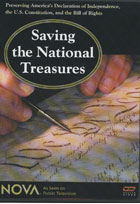
Saving the National Treasures 2005
Distributed by WGBH Boston, 125 Western Avenue, Boston, MA 02134; 617-300-2000
Produced by Stephen Sweigart
Director n/a
DVD, color, 60 min.
Jr. High - Adult
American Studies, History, Conservation & Preservation
Date Entered: 05/27/2005
Reviewed by Marianne D. Muha, E. H. Butler Library, State University of New York College at BuffaloThe Declaration of Independence, the Bill of Rights and the Constitution are considered the nation’s most important charters. Approximately one billion people visit the National Archives in Washington, DC each year to view them. Unfortunately, the documents are all in deteriorating condition after two hundred plus years in existence. This film examines the way a team of historians, conservators, engineers, physicists and chemists developed a way to preserve these national treasures for posterity. The charters had been housed in helium filled, hermetically sealed casements (basically storage boxes) that were beginning to deteriorate. The goal of the 5 year, $5 million project was to devise improved housing for them.
The narrator explains that the documents were done on parchment, the cured skin of a sheep or a cow. An explanation of how parchment is processed into a thin, smooth writing surface is provided. It is vulnerable to the environment because the makeup is skin. The natural aging process had detrimental effects on the documents. A description of how ink is made is also included. With interesting commentary from scholars at MIT, Baruch College, and George Mason University, the film is an excellent lesson in the roles of the charters throughout American history. These papers were literally rolled up and transported in saddlebags every time the Continental Army moved, from Philadelphia to Lancaster, to York, PA and back to Philadelphia. The moves took a toll on the documents.
The team of researchers used computer technology to develop special casements out of milled aluminum, clear colorless glass with special coating to prevent glare, and titanium frames electroplated in gold. The air inside is argon, a colorless gas. The previous casements used silica gel which was commonly considered trouble free at the time. The team had some serious debates over the viability of the use of silica. After strenuous testing including changes in atmospheric pressure it was determined that silica should not be used.
The permanent home of the charters is now the United States National Archives Rotunda. This building underwent an extensive two year renovation to accommodate these national treasures. The last part of the film shows a team of conservators going over the fragile Declaration of Independence. Every crease, crack and tear was examined and measured. The restoration and repair of a ragged edge and a light cleaning were done.
This is an excellent film. It combines very interesting history lessons with fascinating insights into the use of technology for conservation and preservation. It would benefit libraries with American history and conservation collections. Highly recommended.